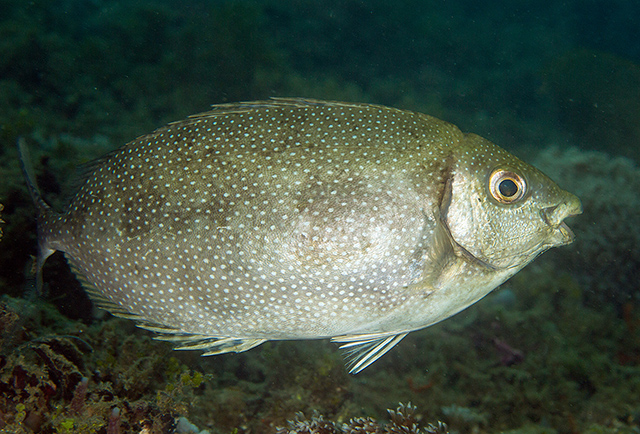| Siganidae (Rabbitfishes) |
| 40 cm TL (male/unsexed) |
|
reef-associated; brackish; marine; depth range 1 - 50 m, oceanodromous |
| Indo-West Pacific: Persian Gulf, Gulf of Oman, Pakistan, India, Sri Lanka, Burma, Thailand, Singapore, Malaysia, Indonesia, Papua New Guinea, Philippines, Cambodia, Viet Nam, south China, Taiwan and Western Australia. Also known from Ryukyu Islands; Palau and Yap in Micronesia (Ref. 1602) and Melanesia (Ref. 712). |
|
Dorsal spines (total): 13-13; Dorsal soft rays (total): 10-10; Anal spines: 7-7; Anal soft rays: 9-9; Vertebrae: 23-23. This species is distinguished by the following characters: body compressed, moderately slender, its depth 2.3-2.8 in SL; last anal-fin spine 1.2-1.5 times in longest anal-fin spine (usually the third); soft parts of dorsal and anal fins low, longest dorsal-fin ray 0.7-1 times in longest dorsal-fin spine; caudal fin almost emarginate in specimens under 10 cm standard length, forked in larger fish; 16-26 (rarely 27) scale rows between lateral line and bases of leading dorsal-fin spines. Colour of body highly variable, greenish grey to yellow brown with numerous (100-200) pearly blue to whitish spots on nape and trunk, match-head size on lower sides; 2-3 rows between first spine of dorsal fin and lateral line (area of eye would cover about 6 spots in this region), and about 10 rows between highest point of lateral line and base of first anal-fin spine; when frightened or injured, sides mottled light and dark brown and cream, creating 6 or 7 regularly spaced, dark diagonal zones with paler zones of similar width between them; dark eye-sized spot usually just behind upper end of gill opening, and a narrow bar along upper edge of gill cover (Ref. 9813, 90102).
Description: Closely resembles S. fuscescens but differs by its slightly more pointed snout and longer pectoral fins (1.1-1.3 in HL vs. 1.4-1.5 in S. fuscescens) (Ref. 1602). Color pattern is similar to that of S. argenteus and S. fuscescens. |
| Adults inhabit inshore, algae reefs, estuaries and in large lagoons with algae-rubble habitats. Mainly common on rocky substrates (Ref. 48637). In contrast to S. fuscescens, this species seems to tolerate more turbid waters, occurring within the vicinity of river mouths especially around seagrass beds. Adults also occur several kilometers offshore in deep, clear waters. Juveniles form very large schools in shallow bays and coral reef flats; school size reduces with size, with adults occurring in groups of 20 individuals or so. Herbivorous, feed on benthic algae and to some extent on seagrass. Fished by trawling and seine netting; bycatch in traps set in deep water and marketed fresh in very large numbers (Ref. 9813). Consumed as food; and have poisonous spines (Ref. 4537). |
|
Least Concern (LC); Date assessed: 10 March 2015 Ref. (130435)
|
| venomous |
|
CAS-SU 27898, 6: 107-182 mm. Reported from Cape D'Aguialr (Ref. 33067); Sharp Island, and Hoi Ha Wan (Ref. 94637). Also reported from Tung Ping Chau (Ref. 119714, 125586); Yan Chau Tong (Ref. 129329); and along the north coast of Lantau Island (Ref. 126090). Juveniles were recorded from Ma Shi Chau, Starfish Bay, Three Fathoms Cove, and Lai Chi Chong (Ref. 125536). Few individuals were also recorded from a submarine cave in Conic Island (Ref. 125576). Sometimes enter brackish waters, eventually rivers and streams. Reported from the Sup Long stream in Lantau Island (Ref. 129476). Sold in live fish markets (Ref. 125552). Caught using hooks and lines, traps, and nets (Ref. 125552). Also Ref. 1419, 12087, 125407, 126271, 128523. |
Source and more info: www.fishbase.org. For personal, classroom, and other internal use only. Not for publication.

